Multi-core suitcase: portable workstation
A gaming laptop for quite a long time was an amusing phrase that knew how to hurt the user: a powerful and frisky device, when purchased, a year later turned into a dusty sneeze starper, who could not afford the high settings, lost much in price and was not particularly ready for the upgrade. Mobile video cards with all sorts of perversions in the form of large amounts of memory, divorced on a very narrow bus or chopped rasterization blocks, which kill the potential of iron, were the norm.

Fortunately, in 2016, NVIDIA and Intel are ready to offer mobility lovers worthy hardware that won't let them down in a year or two, it's a matter of small things: putting together a laptop so that these two years seem like a fairy tale to you.
Lenovo Y910 experienced a generational change: the previous version was good in everything, it had a flagship video card, but it was 980M, which today still burns, but with the released Pascals from NVIDIA, it's not a cake. The new version corrected this annoying misunderstanding, corrected a couple of minor details in the design and now the Y910 is all right with both iron and interior, and with exterior and comfort: one of the best igrabukov of the year. Want evidence? Easy.
')
What has changed this year, and why has the video card ceased to be a “minus” of a laptop? Take a look at this picture:

Actually, this is the main difference: now mobile chips differ from desktop frequencies and the type of memory connection. For this, we say thank you to the new process technology, which allowed us to significantly reduce power consumption and heat dissipation - now the difference is only in operating frequencies that directly affect the hot temper of video cards. In fact, only cooling restrictions are a barrier to further equalizing desktop and mobile systems.
The second significant change was the increase in the efficiency of the architecture: Maxwell was good at the time of release, but NVIDIA managed to dissolve the mess in the lines and architectures, mixing different generations of GPUs within the same digital indices. With the advent of Pascal (NVIDIA 10-series), the mess is over, dedicated mobile chips are not needed, and new chips delight users.
For example, full automatic overclocking within the limits of the temperature limits set at the factory. Moreover, the “accelerator” is turned on not when, but in the most difficult scenes, when the frame rate subsides, and the additional voltage and frequencies are the higher, the more serious the load. The laptop has a video card, which is considered to be the “queen of 1080p-resolution”: the GTX 1070 with a full 8 GB of RAM. Yes, it would be possible to deliver GTX 1080, but in poorly optimized games the difference at such a resolution would be insignificant, but the price would increase noticeably. In those cases when some Poles did not score for optimization, everything is so chic. Now there is no reason to complain about the GPU, go ahead.
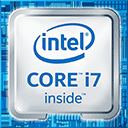 The flagship “mobile” Intel processors easily catch up with their “big brothers” from desktop computers: here are the same 4 cores, 8 streams, impressive frequencies (the most popular for flagship igrobuk i7-6820HK is 3.6 GHz, the top models have 3.7 or 3.8 GHz depending on the integrated graphics), 8 MB of cache memory and full 16 PCI-Express 3.0 lanes for connecting a video card or even two. These demons can withstand temperatures up to 100 degrees Celsius with a rather modest thermal pack of 45 watts - kilogram copper radiators have remained (probably fortunately) a lot of desktops, so that the harsh working conditions impose an appropriate imprint.
The flagship “mobile” Intel processors easily catch up with their “big brothers” from desktop computers: here are the same 4 cores, 8 streams, impressive frequencies (the most popular for flagship igrobuk i7-6820HK is 3.6 GHz, the top models have 3.7 or 3.8 GHz depending on the integrated graphics), 8 MB of cache memory and full 16 PCI-Express 3.0 lanes for connecting a video card or even two. These demons can withstand temperatures up to 100 degrees Celsius with a rather modest thermal pack of 45 watts - kilogram copper radiators have remained (probably fortunately) a lot of desktops, so that the harsh working conditions impose an appropriate imprint.
The flagship processor is really on all fronts lagging behind the desktop: 2 memory channels with 2 slots each, up to 16 GB per module - and here you have 64 gigabytes of RAM. In the laptop, Carl! Yes, not every server can boast such volumes! Add here two, no, TWO NVME connectors for ultra-fast SSD drives (you can put 2x512 GB and enjoy life), and the classic SATA drive in the face of 1 TB HDD, which you can also swap for some SSD disk in a pair terabyte There was not enough space for an external drive (and who needs it today), but just in case Lenovo carefully puts the external drive in the kit. So if you have long wanted a portable DVD-cutter - take the Lenovo Y910 and get a laptop as a gift)

The disk subsystem is really good, but what comes out of the box is even better. SSD Samsung 950 PRO M.2 - server-class drive, which excluded the main “crutch” that hindered the development of SSD-drives: a set of SATA / SAS commands created during the time of rotating pancakes and magnetic heads. For their time and scope, the protocols were good, but SSD requires a different approach to the formation of tasks. Low latency, almost zero cost of finding the right data and demonic read and write speeds require a computer to have a deep sequence of tasks. Older interfaces could not provide it, and modern drives work much better when connected directly to the PCI-Express bus. 512 GB disk version provides consistent read speeds up to 2.5 GB / s and write up to 1.5 GB / s.

To achieve such speeds, the disk requires a high-performance controller (and there it is, a branded Samsung UBX that can work with NVMe and squeeze all the juices out of memory), and its heat release cannot be neglected. With the maximum load on the recording, the Samsung UBX emits up to 6 W of heat, which in the conditions of notebook packaging can cause problems, throwing extra joules into the system’s furnace, and here there are two such discs. As a result, some laptops show decent performance of the disk subsystem only "on the cold." In Lenovo Y910, this problem was solved at the design stage, and the cooling system has a reserve, and air flows, including through the installation zone of SSD-drives. The result speaks for itself - no trotting and easy achievement of passport values for speed. Steeper than this drive, only highly specialized server SSD-drives worth several of these laptops.
Such a filling in a laptop from anyone will knock out a mean tear (and some will even weep in three streams), but to use the owner’s tears for cooling is somehow overkill. Moreover, the theoretical maximum with which to cope is a little more than 150 W of heat. Lenovo Y910 uses sequential cooling components, sucking air in front, bottom and sides, and pulling it alternately from the coldest parts to the hottest.
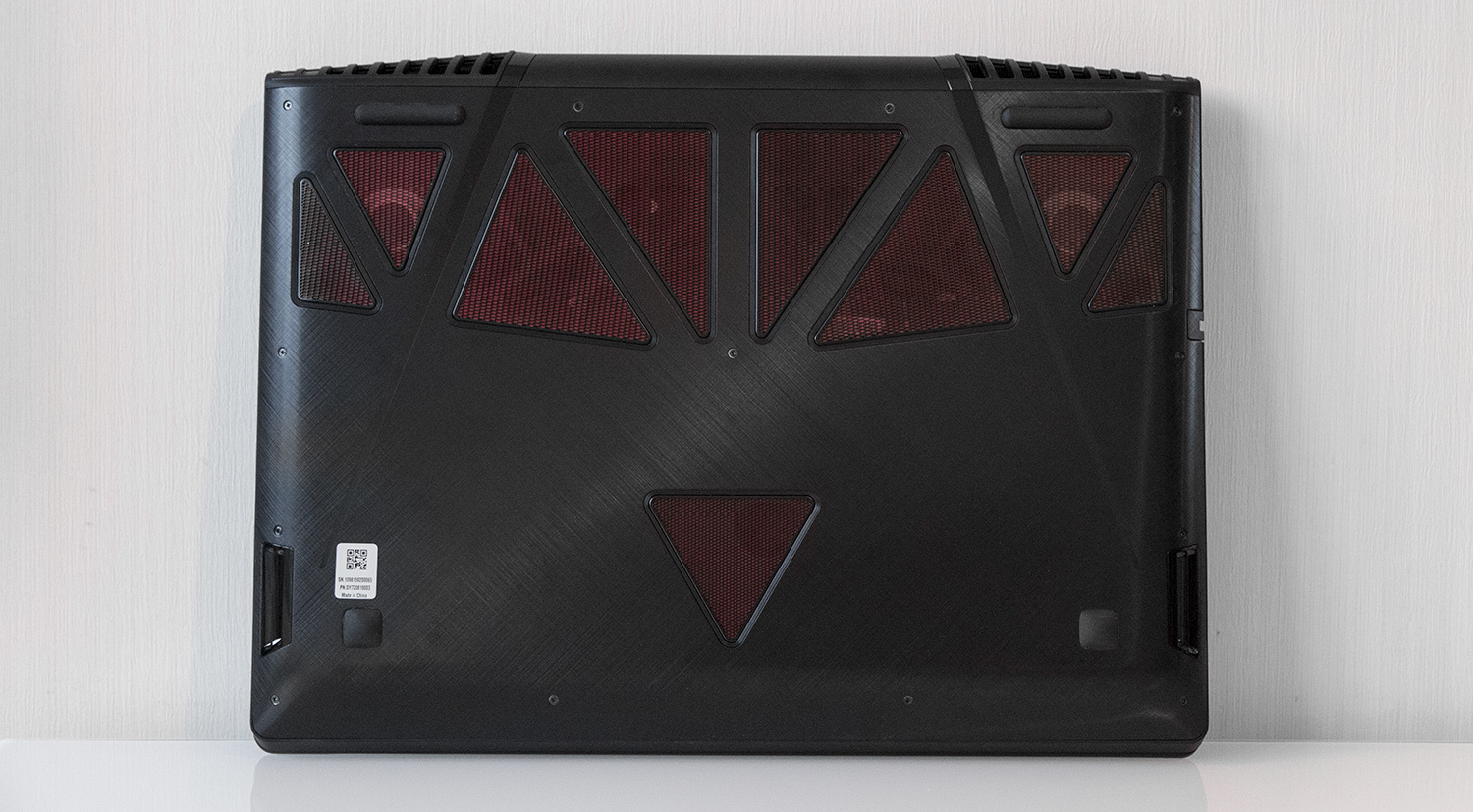
The last radiators, of course, are the outputs of the cooling systems of the CPU and the video card, after which the hot air is instantly thrown back and up behind the display.

As a result, the trackpad and keyboard area remains a bit warm: at least an hour to play, at least three, at least eight. The main thing - do not let the cat lie in front of the "exhaust", and then the pet could happen a haircut-flash.

And, yes, lovers of remotes in bags and factory films on devices will have to shed crocodile tears. Remove all films before operation is necessary , otherwise the cooling system will suffocate and something inside may break. And such a case hardly covers the warranty.
The stuffing is undoubtedly flagship. The consoles never even dreamed of this, as did many desktops, too. It is time to deal with strapping - the periphery and a set of interfaces. In the end, this is a laptop, not a demo stand.
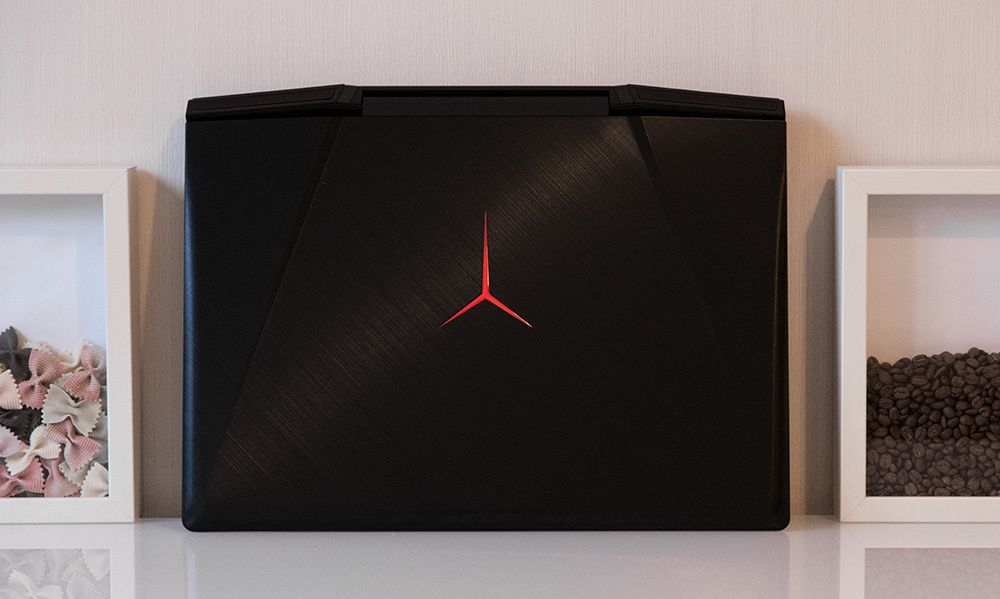
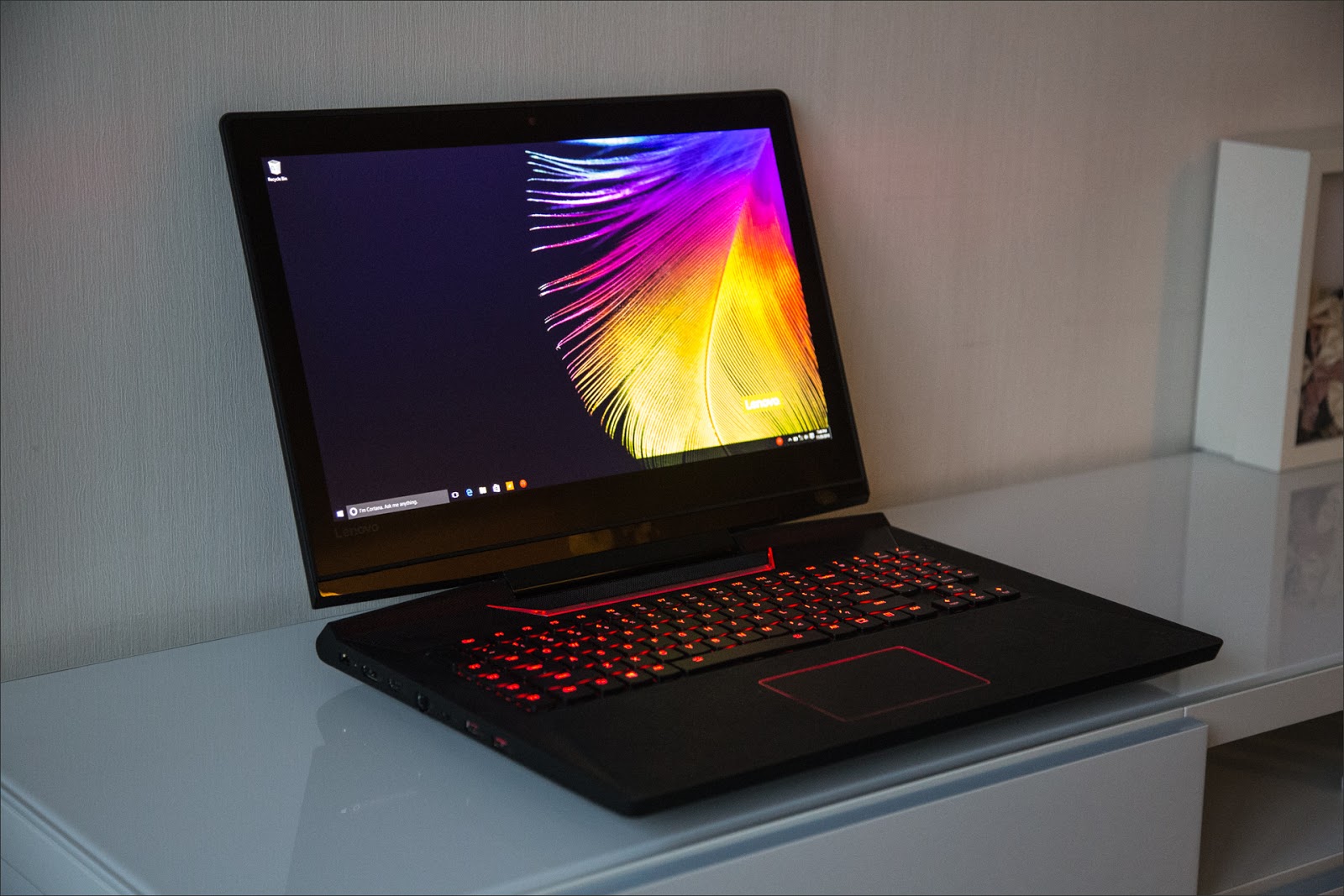
The laptop is the best that could be found and put to a gaming machine. 17-inch FullHD IPS-matrix with a matte finish, refresh rate 75 Hz and support for fast synchronization G-Sync. For players, this means one thing: games will not rest on vertical synchronization if they reach 60 frames per second standard in the PC industry, and in all other cases there will be no gaps, no “rubber” slowing down and speeding up the game process with synchronization enabled.
4k or 2560x1440 on such a diagonal would simply become an extra load on the video card, increase the price, response time, require installation of another backlight system and would not please the above-mentioned buns. The main thing is not the spherical resolution in vacuum, but its relation to the diagonal, the distance to the display and how the matrix is set up, and here all these parameters are in harmony.

It’s kind of stupid to expect 100% sRGB coverage and perfect color accuracy from a gaming display, especially in a laptop, but in the case of the Y910 you don’t have to get upset - the picture is excellent. The manufacturer did not twist the contrast and adjust the colors in a caustic-AMOLED way. The gamma curve on the whole range (except for the extreme 10% on the left and on the right) is very close to the standard.
The white point is shifted to “warm” shades for the sake of reducing the load on vision and general improvement in the perception of the picture, but the main thing is that the color temperature is uniform and does not “float” depending on the brightness. Actually, for basic work with photos, videos and documents, nothing is needed, and a professional can always connect his 4k display via an external DisplayPort or HDMI connector.
At a time when the word “trackpad” (or touchpad) still cut off the ear, all kinds of quicks were in fashion - most people played it with a mouse, but there was a small caste of people who played (and aimed) exclusively from the keyboard - we personally called them “ tractor drivers. Now there is hardly a pervert who will quite seriously play shooters or some kind of “dota” only on the keyboard and even more so on the trackpad: well, you can do it just for fun, but you can poke some step-by-step strategy, but otherwise the good old mouse is better.
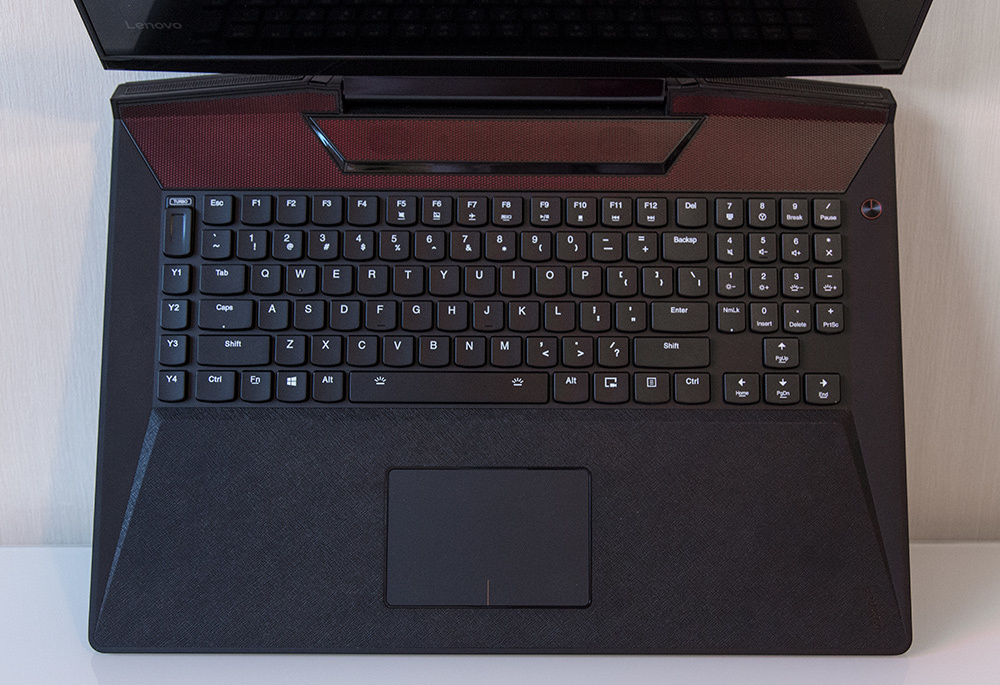
For some, the Y910 is bundled, in our case it was not. However, the mouse and user preferences (especially players) are very different, so much the better: you can choose something familiar, pleasant and convenient. In other cases, the Y910 is a very sensitive and rather large panel with a “silky” sensation of touch. It is pleasant to use the trackpad: he understands familiar gestures, is accurate and generally exudes a delicate apple flavor.

But the main role, of course, was given to the keyboard. A full-fledged "mechanic" was stuffed into the laptop.
Well, how complete. There is no centimeter keystroke here, as well as the usual Cherry MX switches, but that indescribable, perfect feeling of pressing, a faint click that you hear and feel, that feeling of working with something complex and surprisingly pleasant to work - it is there. In the keyboard layout at least perversions.
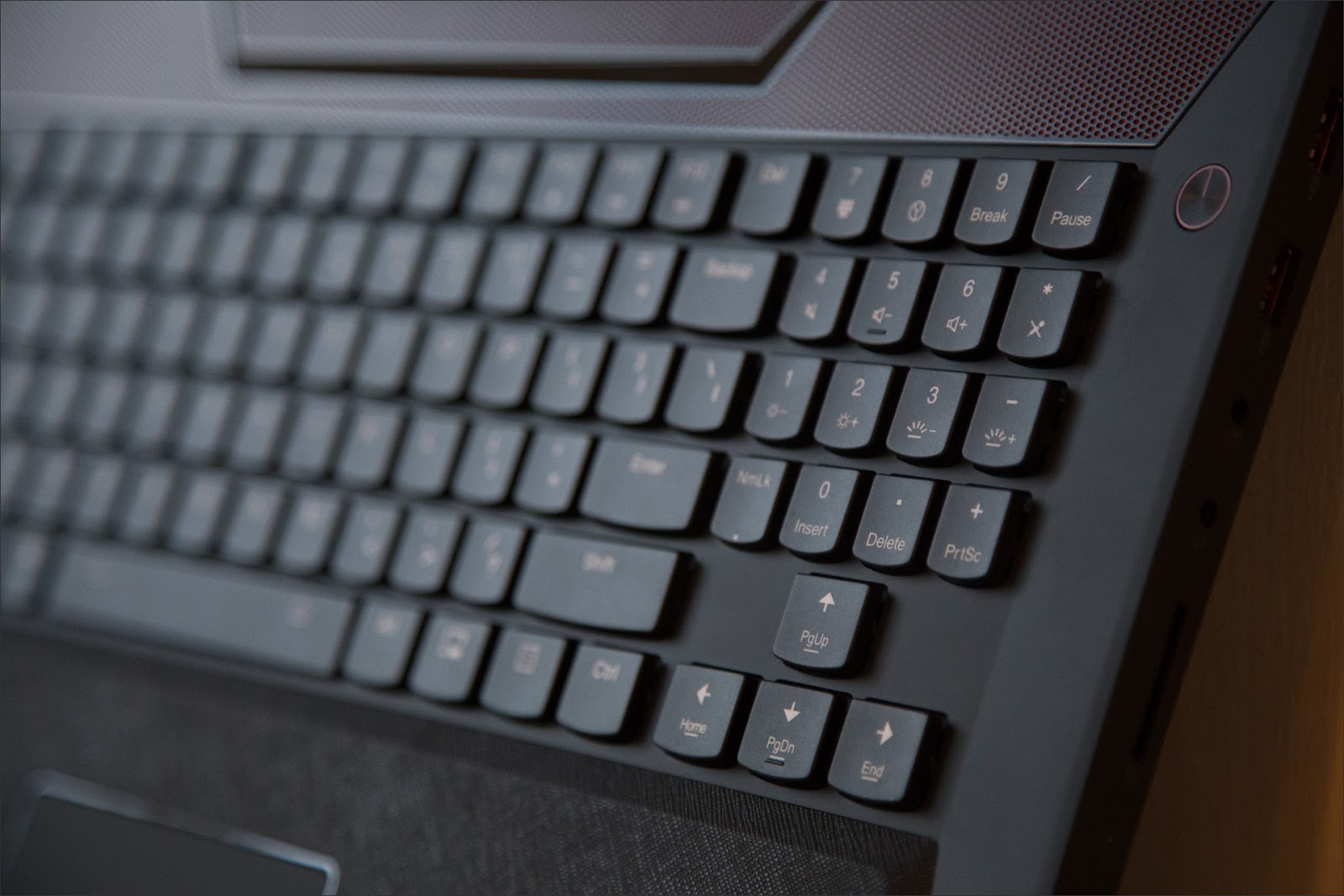
In sum, we have a reasonable set of compromises, which makes working with the keyboard comfortable. And this is with full-size keys, "island" architecture and mechanical switches! It was exactly this kind of progress that was wanted in mobile keyboards, and not these sugary “even thinner, now pressing is almost not felt, and the arrows will be made miserable.” Straight print and the soul rejoices!

Of course, in 2016, there is no way without the backlight. Yes, and certainly RGB to be, tuned and poured. The trend has been preserved since 2015, nothing can be done about it. Do not like these excesses? White, amber or green color is at your service: there is less load on your eyes and no kitsch.

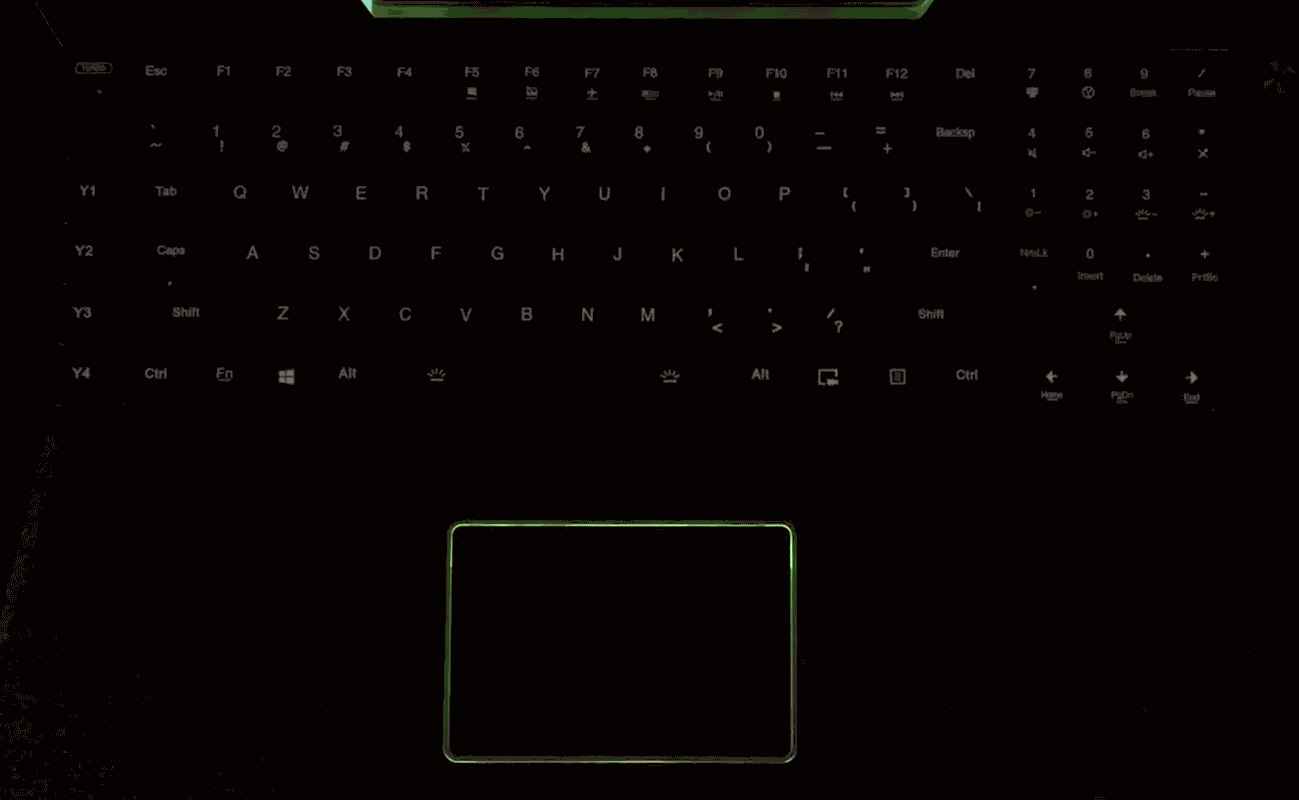
Do iron dope dope, the question is, can this fool curb software? To test more or less objective and cover the maximum of current technologies, we will evaluate the performance in the following games and applications:
The overall performance index compiled in 3D Mark 2016 Time Spy.
GTA V will be responsible for the “old formation” DirectX (DX 10 / 10.1 / 11). It is perfectly optimized, still looks decent and is able to load iron to the fullest.
In DX 12, Battlefield 1 will take the rap - it's young, handsome, well-optimized, and one of the few can really benefit from the new buns available to owners of video cards on Pascal architecture.
OpenGL and Vulkan will be on the conscience of the last DooM. Here you can honestly compare, and see what and how in the game on such hardware.
The Witcher 3 will take the rap for toys with poor optimization: on Ultra-settings in FullHD you won't even have 1080, on medium-high settings (making graphics comparable to the PS4 version), especially expensive hardware is not required, but the top ones don't export much no config Old engine, all things.
Well, as a potential guest from the future will be the VR test platform Steam. All toys are launched at maximum settings, proprietary graphics enhancement technologies (such as NVIDIA hair drawing technology) are turned off.
The result was obtained without overclocking and additional “accelerators”, the laptop was just restarted, the test was launched. The resulting numbers are quite expected, poshaman with the frequencies of the video card and including Boost for the processor, could raise the rating by 500-700 points.

In the test, probably all the latest technologies for working with graphics are crammed. All the advanced shaders, methods of building reflections and glare, distortions of textures and other gizmos, which should in the near future raise the quality of the image in games to an incredible level. And then the grafon will reach a critical mass and the world of games collapses into VR.
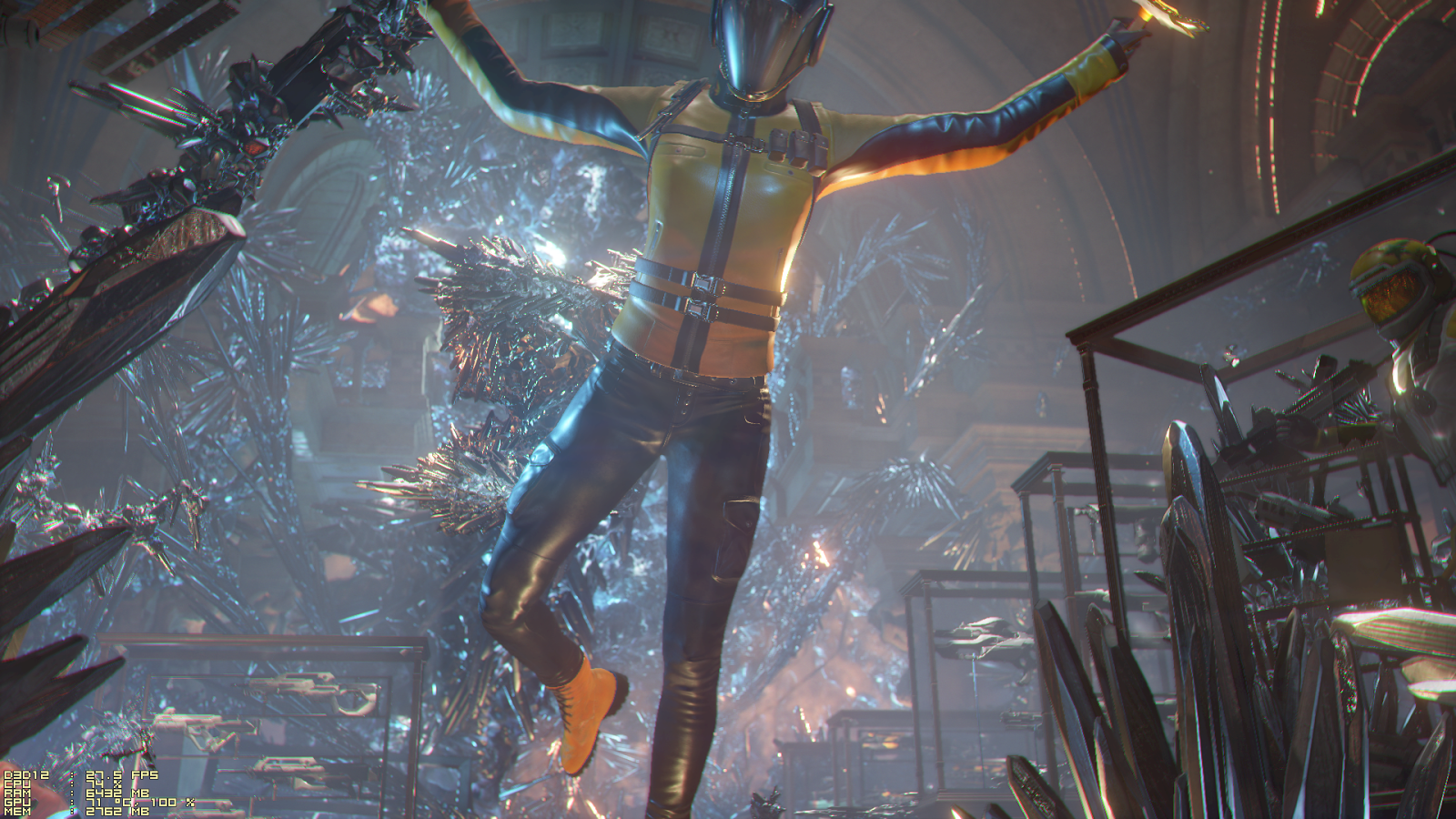
The main thing is not to forget that technology alone is not enough, and without a good gameplay and productive work of artists and game designers, the game will still look like minecraft, how many polygons you don’t need.
One of the major long-term projects of this decade still receives updates for the online part, new content and improvements in optimization. And, which is nice, free! You can love or hate the GTA series as much as you like, but you cannot refuse it in one thing: the elaboration of the world, the gameplay, the plot and the optimization have always been on top. And these amazing glitches ...

Confident 80 frames per second with a minimum of 68. Worthy result, the desktop 1070 showed only a little more: 82 and 70, respectively. And the scenery is beautiful.

Caution, falling airships and Black Bess can cause seizures "Well, I have 5 more minutes." Fascinating action on the display in fair 60+ FPS. The power of Pascal in all its glory.
OpenGL has been an outcast in the PC gaming world for a long time. At one time he gave in to the bold newcomer in the face of DX, for a long time he tried to "do right" what DX did "just to work" (and it worked!) And as a result became what it is now. Theoretically universal and common technology that can not provide consistency and the same performance on different operating systems.
Vulkan was born from low-level AMD Mantle. They abandoned their shader language in favor of the DX-compatible one, simplifying the life of the developers, significantly reduced processor dependency and made it possible to work as close as possible to the iron level, while maintaining a reasonable level of abstraction. The results speak for themselves.
How many “Roach” do not feed, and Geralt has more polygons. The books of Andrzej Sapkowski in the post-Soviet space have long become something of a “Lord of the Rings”. It would be strange if the development rights were given to someone to the left, across the ocean. It can be said that “The Witcher” is one of the export symbols of Poland. Unfortunately, even though the picture is good, the engine has long been time to send for refactoring and processing. Because to use the resources of one of the most powerful display adapters two years after the release and to give less than 60 stable frames per second to FullHD is simply embarrassing.
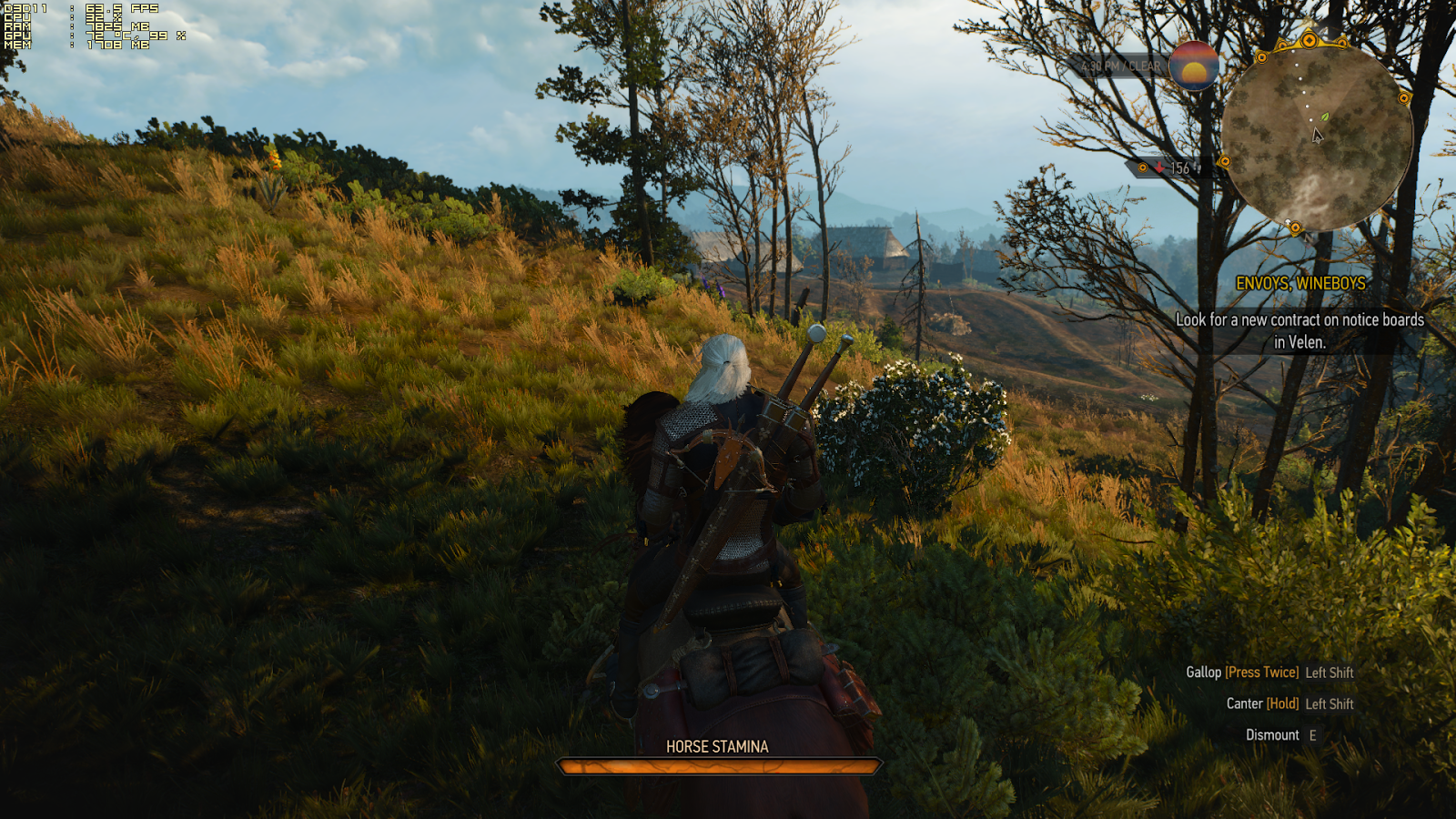
The quick synchronization mode G-SYNC saves the day: the frame rate jumps do not cause a jelly-like effect of a heterogeneous density, through which the plot and gameplay is torn. In principle, the game is not about the grafon, but about the difficult choice and the consequences of the decisions made, so that the settings can be safely reduced to “high” and then in no way deny yourself.
About VR, we hear for two years, and things are there. Only acceptable custom headsets and some kind of toys began to appear. NVIDIA just pulled up the capabilities of the video cards: Pascal'i have a special block that allows you to read the geometry once and “divide” it into two eyes almost free of charge. As a result, we get significant performance gains in VR tests and applications, even in the middle segment, which becomes comparable with the flagships of the past generation.
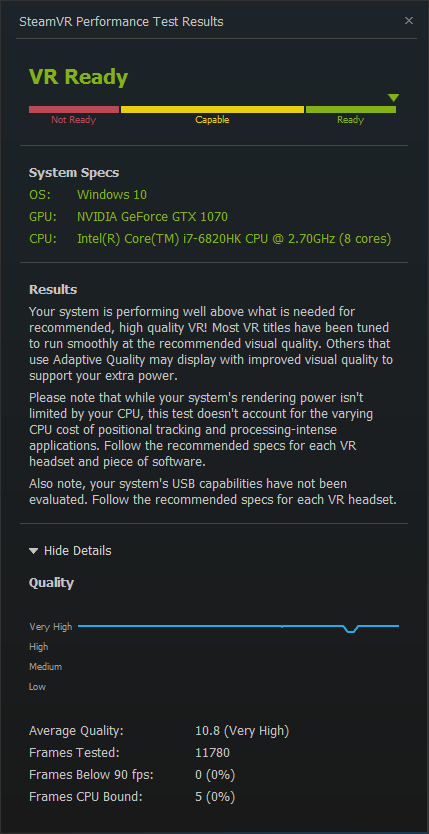
If last year's GTX 980M and the desktop GTX 970 barely overcame the “yellow frontier,” here the test environment “put” the arrow into the green zone with a large margin. You can break the second secret piggy bank - the first will go to the laptop, and the second to the HTC Vive.

The turbo button only works when powered from the mains and allows the system to squeeze ALL JUICE from iron. Well, just all right. In the most difficult moments, the video card catches up on the desktop in terms of frequencies and performance, and the processor with all four cores steps over the psychological barrier of 4 GHz. Just in case, suddenly you forgot: it is still about the laptop. In order to provide increased iron energy in the extreme mode of operation, the PSU is ready to provide up to 230 watts and 1 extra volt to 19 classic, often used in laptop power)
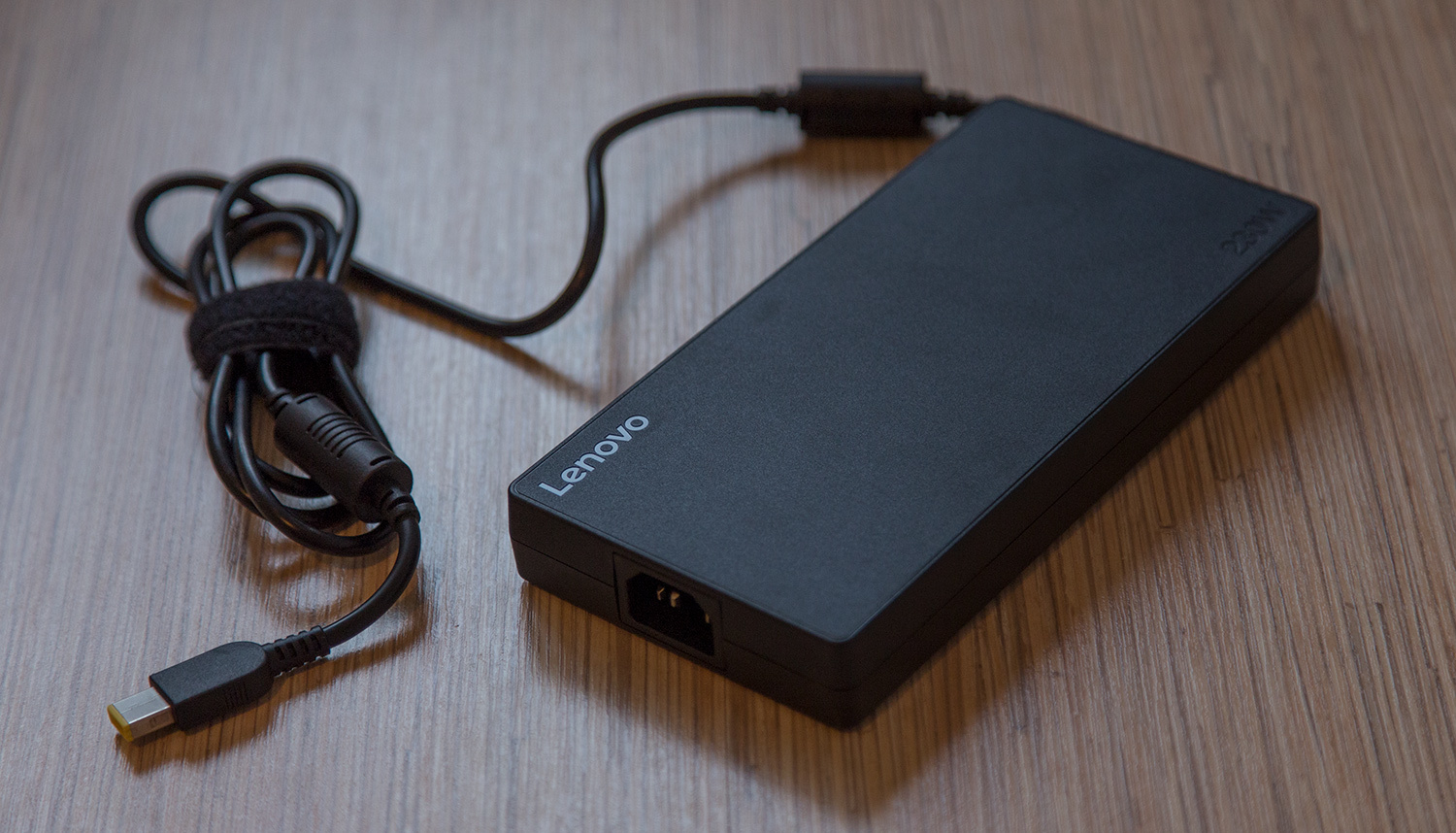

Feature of the latest generation of graphics from NVIDIA - a flexible system of automatic increase of operating frequencies and voltages, if necessary. The only limitation of this system is the heat pack: as long as the computer or laptop is able to remove heat and maintain the video core in comfortable temperature conditions, the frequencies will easily exceed the "passport". In the context of a laptop, a particularly tasty bonus would be to sharpen this system to increase the minimum FPS, rather than the maximum. The auto overclocking system will not fire up the video card once again if it gives an acceptable frame rate, but in heavy scenes the video core can cross the 2 GHz line, and briefly - 2.1 GHz (and this is at a regular 1.5 with a little). For extremely hot conditions, the laptop software provides for the forced inclusion of the maximum power of the cooling system fans.
In addition to the standard keypad backlighting and other settings that have long been banal, the Lenovo Y910 has one thing that really helps users of high-performance laptops. First, the laptop is able to squeeze all the juice from the Internet connection, duplicating Wi-Fi and Ethernet. Background tasks will get the connection easier, demanding to the delay - faster. Secondly, you can manually assign priority to individual applications in the Killer Wlan section. When they run, all sorts of torrents and tabs withporn cartoons will receive what remains of the connection. This chip will run with both toys and messengers: if your unscrupulous provider gives you a connection like that, you don’t want to miss important messages, especially when downloading something that is not very critical - that's it.
One may discuss the design and describe the ports of the periphery as much as possible, sing the laudatory odes to the cooling system and yell “10 out of 10, Lord, 10 out of 10!”, Watching the latest igrostroy masterpiece on one of the best gaming displays that were built into laptops.
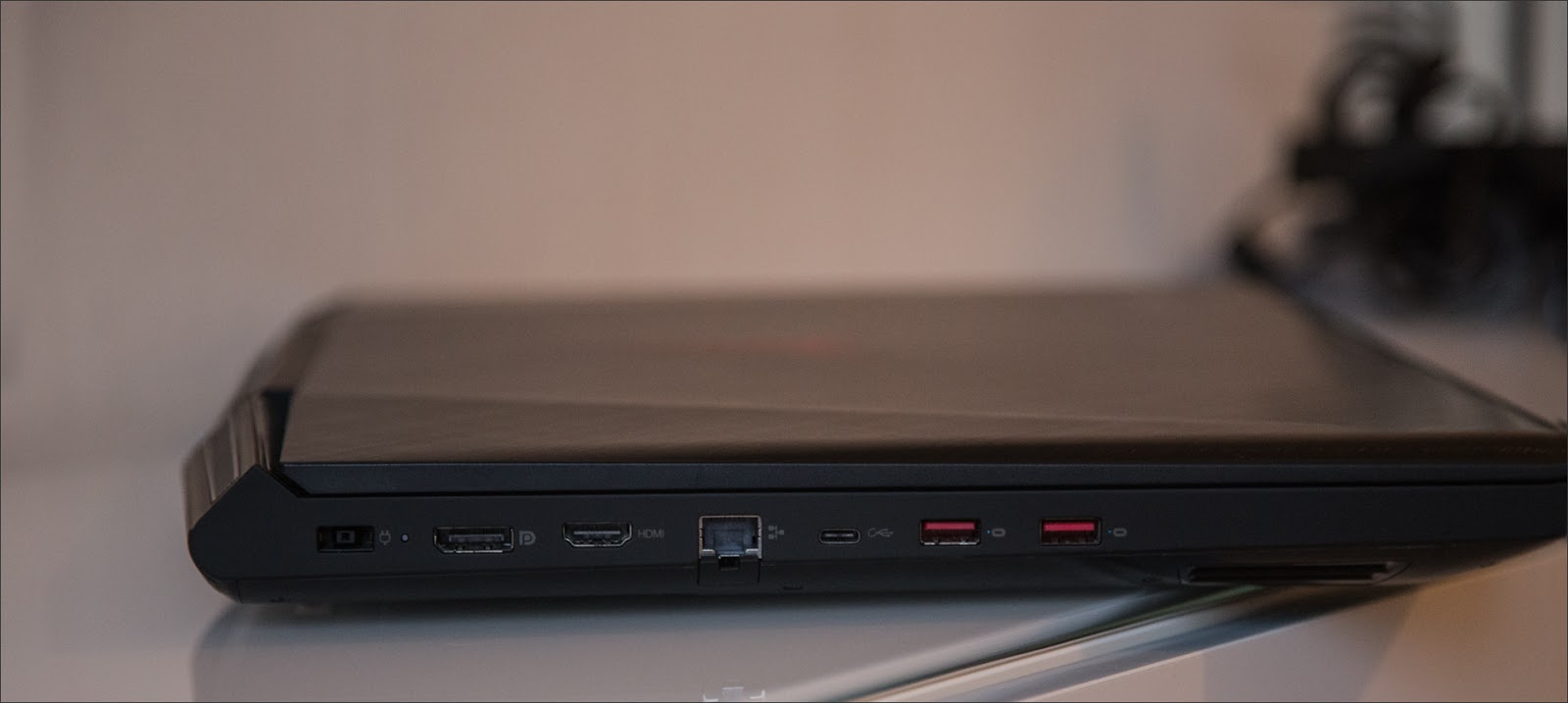
This will not change the essence of the matter: the Y910 contains “excesses” and the potential for upgrading almost everywhere where it is possible, and the processor and video card are made for pre-flagship solutions that are significantly cheaper than their titled “most” fellow epithets and slightly inferior to the real ones tasks. Y910 is not a compromise, but a truly gaming laptop, which can show class in serious workloads and give a lot of fun in the entertainment. Balanced solution on all fronts.

⬝ Display - what you need for games. FullHD does not give too much load, 75 Hz and G-SYNC will save you from other problems.
⬝ Balanced filling. A bunch of processor and video card will be relevant for another two or three years of playing on the “high” settings.
⬝ VR-ready. 1070 will easily digest the VR present and near future.
⬝ Space to upgrade or reserve for the future. . . 64 : . 2-2.5 SSD-.
⬝ «» . ( ) .
⬝ VR ! Lenovo Y910 Oculus Ready, GTX1070 VR-.

⬝ 17 17 . — .
⬝ … . , 100 200 , , SSD- . , .


Fortunately, in 2016, NVIDIA and Intel are ready to offer mobility lovers worthy hardware that won't let them down in a year or two, it's a matter of small things: putting together a laptop so that these two years seem like a fairy tale to you.
Lenovo Y910 experienced a generational change: the previous version was good in everything, it had a flagship video card, but it was 980M, which today still burns, but with the released Pascals from NVIDIA, it's not a cake. The new version corrected this annoying misunderstanding, corrected a couple of minor details in the design and now the Y910 is all right with both iron and interior, and with exterior and comfort: one of the best igrabukov of the year. Want evidence? Easy.
')
Don Grafon
What has changed this year, and why has the video card ceased to be a “minus” of a laptop? Take a look at this picture:

Actually, this is the main difference: now mobile chips differ from desktop frequencies and the type of memory connection. For this, we say thank you to the new process technology, which allowed us to significantly reduce power consumption and heat dissipation - now the difference is only in operating frequencies that directly affect the hot temper of video cards. In fact, only cooling restrictions are a barrier to further equalizing desktop and mobile systems.
The second significant change was the increase in the efficiency of the architecture: Maxwell was good at the time of release, but NVIDIA managed to dissolve the mess in the lines and architectures, mixing different generations of GPUs within the same digital indices. With the advent of Pascal (NVIDIA 10-series), the mess is over, dedicated mobile chips are not needed, and new chips delight users.
For example, full automatic overclocking within the limits of the temperature limits set at the factory. Moreover, the “accelerator” is turned on not when, but in the most difficult scenes, when the frame rate subsides, and the additional voltage and frequencies are the higher, the more serious the load. The laptop has a video card, which is considered to be the “queen of 1080p-resolution”: the GTX 1070 with a full 8 GB of RAM. Yes, it would be possible to deliver GTX 1080, but in poorly optimized games the difference at such a resolution would be insignificant, but the price would increase noticeably. In those cases when some Poles did not score for optimization, everything is so chic. Now there is no reason to complain about the GPU, go ahead.
Warm heart
 The flagship “mobile” Intel processors easily catch up with their “big brothers” from desktop computers: here are the same 4 cores, 8 streams, impressive frequencies (the most popular for flagship igrobuk i7-6820HK is 3.6 GHz, the top models have 3.7 or 3.8 GHz depending on the integrated graphics), 8 MB of cache memory and full 16 PCI-Express 3.0 lanes for connecting a video card or even two. These demons can withstand temperatures up to 100 degrees Celsius with a rather modest thermal pack of 45 watts - kilogram copper radiators have remained (probably fortunately) a lot of desktops, so that the harsh working conditions impose an appropriate imprint.
The flagship “mobile” Intel processors easily catch up with their “big brothers” from desktop computers: here are the same 4 cores, 8 streams, impressive frequencies (the most popular for flagship igrobuk i7-6820HK is 3.6 GHz, the top models have 3.7 or 3.8 GHz depending on the integrated graphics), 8 MB of cache memory and full 16 PCI-Express 3.0 lanes for connecting a video card or even two. These demons can withstand temperatures up to 100 degrees Celsius with a rather modest thermal pack of 45 watts - kilogram copper radiators have remained (probably fortunately) a lot of desktops, so that the harsh working conditions impose an appropriate imprint.Infinite memory
The flagship processor is really on all fronts lagging behind the desktop: 2 memory channels with 2 slots each, up to 16 GB per module - and here you have 64 gigabytes of RAM. In the laptop, Carl! Yes, not every server can boast such volumes! Add here two, no, TWO NVME connectors for ultra-fast SSD drives (you can put 2x512 GB and enjoy life), and the classic SATA drive in the face of 1 TB HDD, which you can also swap for some SSD disk in a pair terabyte There was not enough space for an external drive (and who needs it today), but just in case Lenovo carefully puts the external drive in the kit. So if you have long wanted a portable DVD-cutter - take the Lenovo Y910 and get a laptop as a gift)

The disk subsystem is really good, but what comes out of the box is even better. SSD Samsung 950 PRO M.2 - server-class drive, which excluded the main “crutch” that hindered the development of SSD-drives: a set of SATA / SAS commands created during the time of rotating pancakes and magnetic heads. For their time and scope, the protocols were good, but SSD requires a different approach to the formation of tasks. Low latency, almost zero cost of finding the right data and demonic read and write speeds require a computer to have a deep sequence of tasks. Older interfaces could not provide it, and modern drives work much better when connected directly to the PCI-Express bus. 512 GB disk version provides consistent read speeds up to 2.5 GB / s and write up to 1.5 GB / s.

To achieve such speeds, the disk requires a high-performance controller (and there it is, a branded Samsung UBX that can work with NVMe and squeeze all the juices out of memory), and its heat release cannot be neglected. With the maximum load on the recording, the Samsung UBX emits up to 6 W of heat, which in the conditions of notebook packaging can cause problems, throwing extra joules into the system’s furnace, and here there are two such discs. As a result, some laptops show decent performance of the disk subsystem only "on the cold." In Lenovo Y910, this problem was solved at the design stage, and the cooling system has a reserve, and air flows, including through the installation zone of SSD-drives. The result speaks for itself - no trotting and easy achievement of passport values for speed. Steeper than this drive, only highly specialized server SSD-drives worth several of these laptops.
Cold temper
Such a filling in a laptop from anyone will knock out a mean tear (and some will even weep in three streams), but to use the owner’s tears for cooling is somehow overkill. Moreover, the theoretical maximum with which to cope is a little more than 150 W of heat. Lenovo Y910 uses sequential cooling components, sucking air in front, bottom and sides, and pulling it alternately from the coldest parts to the hottest.

The last radiators, of course, are the outputs of the cooling systems of the CPU and the video card, after which the hot air is instantly thrown back and up behind the display.

As a result, the trackpad and keyboard area remains a bit warm: at least an hour to play, at least three, at least eight. The main thing - do not let the cat lie in front of the "exhaust", and then the pet could happen a haircut-flash.

And, yes, lovers of remotes in bags and factory films on devices will have to shed crocodile tears. Remove all films before operation is necessary , otherwise the cooling system will suffocate and something inside may break. And such a case hardly covers the warranty.
Form corresponding to the content
The stuffing is undoubtedly flagship. The consoles never even dreamed of this, as did many desktops, too. It is time to deal with strapping - the periphery and a set of interfaces. In the end, this is a laptop, not a demo stand.


Display
The laptop is the best that could be found and put to a gaming machine. 17-inch FullHD IPS-matrix with a matte finish, refresh rate 75 Hz and support for fast synchronization G-Sync. For players, this means one thing: games will not rest on vertical synchronization if they reach 60 frames per second standard in the PC industry, and in all other cases there will be no gaps, no “rubber” slowing down and speeding up the game process with synchronization enabled.
4k or 2560x1440 on such a diagonal would simply become an extra load on the video card, increase the price, response time, require installation of another backlight system and would not please the above-mentioned buns. The main thing is not the spherical resolution in vacuum, but its relation to the diagonal, the distance to the display and how the matrix is set up, and here all these parameters are in harmony.

It’s kind of stupid to expect 100% sRGB coverage and perfect color accuracy from a gaming display, especially in a laptop, but in the case of the Y910 you don’t have to get upset - the picture is excellent. The manufacturer did not twist the contrast and adjust the colors in a caustic-AMOLED way. The gamma curve on the whole range (except for the extreme 10% on the left and on the right) is very close to the standard.
The white point is shifted to “warm” shades for the sake of reducing the load on vision and general improvement in the perception of the picture, but the main thing is that the color temperature is uniform and does not “float” depending on the brightness. Actually, for basic work with photos, videos and documents, nothing is needed, and a professional can always connect his 4k display via an external DisplayPort or HDMI connector.
Keyboard and trackpad
At a time when the word “trackpad” (or touchpad) still cut off the ear, all kinds of quicks were in fashion - most people played it with a mouse, but there was a small caste of people who played (and aimed) exclusively from the keyboard - we personally called them “ tractor drivers. Now there is hardly a pervert who will quite seriously play shooters or some kind of “dota” only on the keyboard and even more so on the trackpad: well, you can do it just for fun, but you can poke some step-by-step strategy, but otherwise the good old mouse is better.

For some, the Y910 is bundled, in our case it was not. However, the mouse and user preferences (especially players) are very different, so much the better: you can choose something familiar, pleasant and convenient. In other cases, the Y910 is a very sensitive and rather large panel with a “silky” sensation of touch. It is pleasant to use the trackpad: he understands familiar gestures, is accurate and generally exudes a delicate apple flavor.

But the main role, of course, was given to the keyboard. A full-fledged "mechanic" was stuffed into the laptop.
Well, how complete. There is no centimeter keystroke here, as well as the usual Cherry MX switches, but that indescribable, perfect feeling of pressing, a faint click that you hear and feel, that feeling of working with something complex and surprisingly pleasant to work - it is there. In the keyboard layout at least perversions.
- On the left is one additional column of keys: macro buttons and a turbo mode switch. You get used to this offset by one character in a couple of days;
- NUM-block, combined with the main FN-triggers just went up relative to the base row of buttons. Not scary;
- Under the NUM, there are full-sized arrows allocated to a separate space. Nobody began to push them into a single block with letters and numbers, so it's nice to use.

In sum, we have a reasonable set of compromises, which makes working with the keyboard comfortable. And this is with full-size keys, "island" architecture and mechanical switches! It was exactly this kind of progress that was wanted in mobile keyboards, and not these sugary “even thinner, now pressing is almost not felt, and the arrows will be made miserable.” Straight print and the soul rejoices!

Of course, in 2016, there is no way without the backlight. Yes, and certainly RGB to be, tuned and poured. The trend has been preserved since 2015, nothing can be done about it. Do not like these excesses? White, amber or green color is at your service: there is less load on your eyes and no kitsch.


Performance
Do iron dope dope, the question is, can this fool curb software? To test more or less objective and cover the maximum of current technologies, we will evaluate the performance in the following games and applications:
The overall performance index compiled in 3D Mark 2016 Time Spy.
GTA V will be responsible for the “old formation” DirectX (DX 10 / 10.1 / 11). It is perfectly optimized, still looks decent and is able to load iron to the fullest.
In DX 12, Battlefield 1 will take the rap - it's young, handsome, well-optimized, and one of the few can really benefit from the new buns available to owners of video cards on Pascal architecture.
OpenGL and Vulkan will be on the conscience of the last DooM. Here you can honestly compare, and see what and how in the game on such hardware.
The Witcher 3 will take the rap for toys with poor optimization: on Ultra-settings in FullHD you won't even have 1080, on medium-high settings (making graphics comparable to the PS4 version), especially expensive hardware is not required, but the top ones don't export much no config Old engine, all things.
Well, as a potential guest from the future will be the VR test platform Steam. All toys are launched at maximum settings, proprietary graphics enhancement technologies (such as NVIDIA hair drawing technology) are turned off.
▍3D Mark
The result was obtained without overclocking and additional “accelerators”, the laptop was just restarted, the test was launched. The resulting numbers are quite expected, poshaman with the frequencies of the video card and including Boost for the processor, could raise the rating by 500-700 points.

In the test, probably all the latest technologies for working with graphics are crammed. All the advanced shaders, methods of building reflections and glare, distortions of textures and other gizmos, which should in the near future raise the quality of the image in games to an incredible level. And then the grafon will reach a critical mass and the world of games collapses into VR.

The main thing is not to forget that technology alone is not enough, and without a good gameplay and productive work of artists and game designers, the game will still look like minecraft, how many polygons you don’t need.
▍GTA V
One of the major long-term projects of this decade still receives updates for the online part, new content and improvements in optimization. And, which is nice, free! You can love or hate the GTA series as much as you like, but you cannot refuse it in one thing: the elaboration of the world, the gameplay, the plot and the optimization have always been on top. And these amazing glitches ...

Confident 80 frames per second with a minimum of 68. Worthy result, the desktop 1070 showed only a little more: 82 and 70, respectively. And the scenery is beautiful.

▍Battlefield 1
Caution, falling airships and Black Bess can cause seizures "Well, I have 5 more minutes." Fascinating action on the display in fair 60+ FPS. The power of Pascal in all its glory.
▍DOOM
OpenGL has been an outcast in the PC gaming world for a long time. At one time he gave in to the bold newcomer in the face of DX, for a long time he tried to "do right" what DX did "just to work" (and it worked!) And as a result became what it is now. Theoretically universal and common technology that can not provide consistency and the same performance on different operating systems.
Vulkan was born from low-level AMD Mantle. They abandoned their shader language in favor of the DX-compatible one, simplifying the life of the developers, significantly reduced processor dependency and made it possible to work as close as possible to the iron level, while maintaining a reasonable level of abstraction. The results speak for themselves.
▍Witcher 3: Blood and Wine
How many “Roach” do not feed, and Geralt has more polygons. The books of Andrzej Sapkowski in the post-Soviet space have long become something of a “Lord of the Rings”. It would be strange if the development rights were given to someone to the left, across the ocean. It can be said that “The Witcher” is one of the export symbols of Poland. Unfortunately, even though the picture is good, the engine has long been time to send for refactoring and processing. Because to use the resources of one of the most powerful display adapters two years after the release and to give less than 60 stable frames per second to FullHD is simply embarrassing.

The quick synchronization mode G-SYNC saves the day: the frame rate jumps do not cause a jelly-like effect of a heterogeneous density, through which the plot and gameplay is torn. In principle, the game is not about the grafon, but about the difficult choice and the consequences of the decisions made, so that the settings can be safely reduced to “high” and then in no way deny yourself.
▍SteamVR Test
About VR, we hear for two years, and things are there. Only acceptable custom headsets and some kind of toys began to appear. NVIDIA just pulled up the capabilities of the video cards: Pascal'i have a special block that allows you to read the geometry once and “divide” it into two eyes almost free of charge. As a result, we get significant performance gains in VR tests and applications, even in the middle segment, which becomes comparable with the flagships of the past generation.

If last year's GTX 980M and the desktop GTX 970 barely overcame the “yellow frontier,” here the test environment “put” the arrow into the green zone with a large margin. You can break the second secret piggy bank - the first will go to the laptop, and the second to the HTC Vive.
Uncompromising
We had 4 cores, 64 gigabytes of RAM, a GTX 1070, a mechanical keyboard and a whole host of ports of all sorts and colors, as well as the best terabyte SSD, excellent cooling system, nice design, hardware overclocking button and a matte 17-inch display with G-SYNC . Not that it was the necessary supply for toys. But if you started shopping for a sale on Steam, it becomes difficult to stop. The only thing that worried me was overclocking. There is nothing more helpless, irresponsible and spoiled than Mommy's overclockers. I knew that sooner or later we will move on to this rubbish.

The turbo button only works when powered from the mains and allows the system to squeeze ALL JUICE from iron. Well, just all right. In the most difficult moments, the video card catches up on the desktop in terms of frequencies and performance, and the processor with all four cores steps over the psychological barrier of 4 GHz. Just in case, suddenly you forgot: it is still about the laptop. In order to provide increased iron energy in the extreme mode of operation, the PSU is ready to provide up to 230 watts and 1 extra volt to 19 classic, often used in laptop power)


Feature of the latest generation of graphics from NVIDIA - a flexible system of automatic increase of operating frequencies and voltages, if necessary. The only limitation of this system is the heat pack: as long as the computer or laptop is able to remove heat and maintain the video core in comfortable temperature conditions, the frequencies will easily exceed the "passport". In the context of a laptop, a particularly tasty bonus would be to sharpen this system to increase the minimum FPS, rather than the maximum. The auto overclocking system will not fire up the video card once again if it gives an acceptable frame rate, but in heavy scenes the video core can cross the 2 GHz line, and briefly - 2.1 GHz (and this is at a regular 1.5 with a little). For extremely hot conditions, the laptop software provides for the forced inclusion of the maximum power of the cooling system fans.
Soft buns
In addition to the standard keypad backlighting and other settings that have long been banal, the Lenovo Y910 has one thing that really helps users of high-performance laptops. First, the laptop is able to squeeze all the juice from the Internet connection, duplicating Wi-Fi and Ethernet. Background tasks will get the connection easier, demanding to the delay - faster. Secondly, you can manually assign priority to individual applications in the Killer Wlan section. When they run, all sorts of torrents and tabs with
In total
One may discuss the design and describe the ports of the periphery as much as possible, sing the laudatory odes to the cooling system and yell “10 out of 10, Lord, 10 out of 10!”, Watching the latest igrostroy masterpiece on one of the best gaming displays that were built into laptops.

This will not change the essence of the matter: the Y910 contains “excesses” and the potential for upgrading almost everywhere where it is possible, and the processor and video card are made for pre-flagship solutions that are significantly cheaper than their titled “most” fellow epithets and slightly inferior to the real ones tasks. Y910 is not a compromise, but a truly gaming laptop, which can show class in serious workloads and give a lot of fun in the entertainment. Balanced solution on all fronts.

▍ Pluses:
⬝ Display - what you need for games. FullHD does not give too much load, 75 Hz and G-SYNC will save you from other problems.
⬝ Balanced filling. A bunch of processor and video card will be relevant for another two or three years of playing on the “high” settings.
⬝ VR-ready. 1070 will easily digest the VR present and near future.
⬝ Space to upgrade or reserve for the future. . . 64 : . 2-2.5 SSD-.
⬝ «» . ( ) .
⬝ VR ! Lenovo Y910 Oculus Ready, GTX1070 VR-.

▍:
⬝ 17 17 . — .
⬝ … . , 100 200 , , SSD- . , .

Source: https://habr.com/ru/post/400155/
All Articles